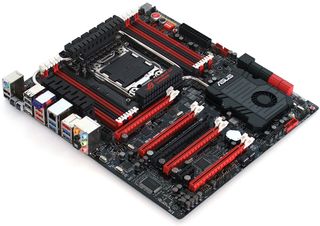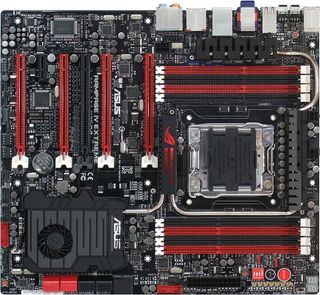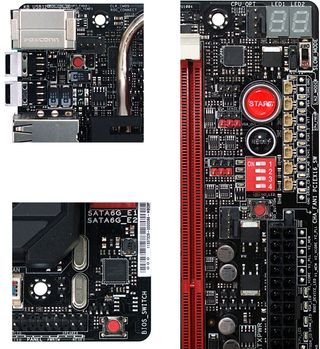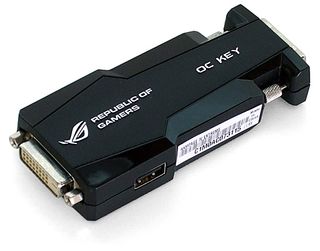Overclocking: Asus Rampage IV Extreme Versus EVGA X79 FTW
Many companies claim to offer the best overclocking for your money, yet only two compete for the best overclocking at the very highest price point. Today we put those claims to the test, including a full set of benchmarks to analyze performance gains.
Asus Rampage IV Extreme
Asus’ Republic of Gamers motherboards add exclusive overclocking technologies to all other features expected from high-end enthusiast products. One of the Rampage IV Extreme’s USB ports can, for example, be repurposed at the push of an I/O panel button to control clock speed via the company's now-famous ROG Connect technology.

Reeling in the gamer crowd is the Rampage IV Extreme’s PCIe x16 slot layout, which Asus highlights with red connectors, even though there’s a fifth (grey) slot in the middle. The layout actually devotes sixteen lanes exclusively to the top slot, sends eight lanes to the second slot, and allots the fourth slot its full sixteen. The fifth x16 slot takes eight lanes from the fourth whenever it’s populated (using automatic configuration). The initial result is two-way graphics at x16-x16 transfers with quadruple slot spacing, three-way graphics at x16-x8-x16 transfers with double slot spacing, or four-way graphics at x16-x8-x8-x8 transfers with double slot spacing.
The grey slot adds the option of three-way graphics with triple slot spacing by stealing all eight lanes from the second slot. The resulting lane configuration is x16-x8-x8 using the top, middle (grey) and bottom connectors.

Some of the Rampage IV Extreme’s more extreme overclocking features can be seen in the above full-view shot, such as the pair of Subzero Sense temperature interfaces next to SATA that are used with separately-purchased K-type thermocouples.
An internal CLR_CMOS button is placed in the top-rear corner, while a BIOS IC selector switch is found at the bottom front.

The top-front edge looks far more interesting, with its selection of status LEDs, line voltage detection points, and PCIe slot disabling switches. The Go button jumps from current settings to a preset overclock, while Slow Mode allows the system to be momentarily dropped from a super-high overclock in order to prevent cold-crashes at light load when using liquid nitrogen.
Two sets of jumpers perform the amazing trick of monitoring and setting GPU voltage from the motherboard, but require leads to be soldered to each card. Making this technology even more useful is that the settings can be changed in firmware, software (Asus TurboV Evo), or remotely (Asus OC Key)
Stay on the Cutting Edge
Join the experts who read Tom's Hardware for the inside track on enthusiast PC tech news — and have for over 25 years. We'll send breaking news and in-depth reviews of CPUs, GPUs, AI, maker hardware and more straight to your inbox.
The enthusiast-expected additions like on-board Start/Reset buttons and a Port 80 display are also found.

Asus OC Key adds video overlay of key firmware features (monitoring and O/C controls) to Asus' ROG Connect technology. This allows a user to do his “remote” tuning from a separate keyboard, locally. The benefits of being outside the influence of an operating system remain.

The Rampage IV Extreme is packed with cables, connectors, and PCIe bridges, even including an X-Socket adapter that allows users to remove Intel’s integrated cooler support frame for increased compatibility with LGA 1366 coolers. The only missing piece is a three-way SLI bridge for triple-slot card spacing, enabled by the grey slot that Asus barely mentions. Bridges for double-slot spacing are available in both three-way and four-way SLI, along with flexible dual-card bridges that span the four slots between full x16-length connectors.
Current page: Asus Rampage IV Extreme
Prev Page X79's Last Hurrah Before Ivy Bridge Next Page Rampage IV Extreme Firmware Overclocking-
EzioAs Nice article.Reply
Where is the MSI Big Bang Xpower II? That's known to be a great board for overclocking as well. -
schn1tt3r I'd love to see a comparison like this between the Rampage IV Extreme and the Rampage IV Formula. The price difference is over $100 and I don't see WHY. 8 RAM slots is something I would never fill up so the Formula and its 4 slots seems perfect to me.Reply -
hellfire24 i would take rampage iv formula.it's cheaper and provides similar features.who needs 4-way sli?Reply -
Crashman WR2Kind of a lukewarm recommendation. Just 'Tom's Hardware Approved award'Only because there aren't many readers who can get $50 of value out of its specific feature set, compared to the WS.Reply -
halcyon I wish I hadn't seen this. I really do. I have no excuse to get an X79 based system. I don't. I..do...not. I want. ...but I can't. Food. Food is important.Reply -
master9716 You guys really need to start Testing @ 5760x1080 !!! , Monitors go for really cheap on craiglist now from wholesellers , you can buy 3 24" leds for like 300 bucks so a lot of people that I know have been runing 3 monitor setups for a while.Reply -
jaquith Thanks Thomas for another enlightening Article! :)Reply
Just knowing the ASUS and EVGA from past history (LGA 1366) which may or may not play any role here, ASUS tends to (lets call it adjust) the CPU vCore and VTT/VCCSA higher than advertised vs EVGA which probably explains* the problems with both the high frequency RAM and CPU OC's.
The disturbing thing to 'me' was the regulator voltages. I know the EVGA uses 12+2 vs ASUS's 8+3+(2+2) PWM and it's all digital controlled on ASUS, (*)but IDK if the EVGA is digitally controlled which might explain the inefficiency and OC.
The EVGA has always been a very 'manual' MOBO, so in that regard I'm not surprised you had to dive into the BIOS. I have no doubts if you raised the EVGA's voltages vs a cloned ASUS optimized OC set that you'd have no problems obtaining the SAME 4.8GHz OC. Both boards offer voltage check points and I'd be very interesting how they compared.
Just the other day I updated my ASUS BIOS and right-off I noticed an increased vCore increase by +0.01v~+0.015v and as part of the documented (improvements) was 'Improved Stability' ; yeah sure if you raise the vCore or VTT/VCCSA, phase, etc profiles... Now I have to redo my validations.
The most important testing here, to me, is the Baseline Comparison which tells me EVGA has some work to do ASAP, and hopefully a BIOS update can close the gaps. Further, personally I won't buy or recommend any X79 MOBO unless it offers an 8xDIMM option. In the forum it's been very clear which X79's I recommend since day one, and the ASUS R4E has always been on top on my list if you can afford it! ;) -
spookyman Considering Ivy Bridge is around the corner. Would it be beneficial in buying a Sandy Bridge-E board?Reply
Most Popular


